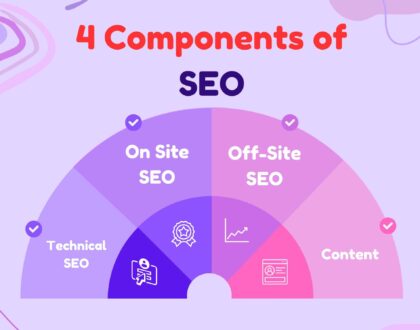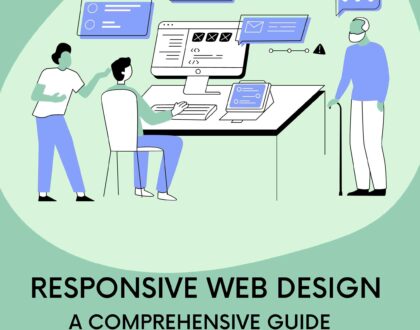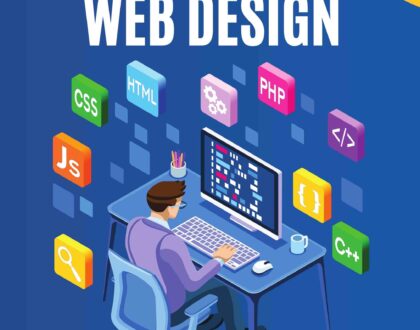In the ever-evolving landscape of the digital world, where online visibility is paramount, Search Engine Optimization (SEO) has emerged as an essential strategy for businesses and individuals looking to enhance their online presence. SEO involves a multitude of elements working harmoniously to improve a website’s ranking on search engine results pages (SERPs). While the intricacies of SEO can be complex, it can be broken down into four core components: on-site SEO, off-site SEO, content, and technical SEO. In this comprehensive guide, we will delve into each of these components, exploring their significance, strategies, and impact on search engine rankings.
The main 4 Components of SEO
1. On-Site SEO
On-site SEO, also known as on-page SEO, refers to the optimization efforts made directly on the website itself to improve its visibility and relevancy in search engine results. This component involves a series of techniques and practices that aim to make the website more appealing to both users and search engines.
Importance of On-Site SEO
On-site SEO forms the foundation of a successful SEO strategy. It serves as the bridge between the content and technical aspects of a website, ensuring that search engines can understand and interpret the content effectively. By optimizing on-site elements, you create a better user experience, increase the chances of your content being indexed accurately, and enhance your website’s overall credibility.
Key Aspects of On-Site SEO
Keyword Optimization:
Keywords are the cornerstone of SEO. Conduct thorough keyword research to identify relevant and high-performing keywords that align with your content. Strategically integrate these keywords into your website’s content, headings, meta tags, and URLs.
High-Quality Content:
Content is king in the digital realm. Create informative, valuable, and engaging content that addresses the needs and queries of your target audience. Ensure proper formatting, readability, and the inclusion of multimedia elements like images and videos.
Meta Tags:
Meta tags, including the meta title and meta description, provide a concise summary of what a webpage is about. Craft compelling meta tags that incorporate targeted keywords and accurately represent the content on the page.
URL Structure:
A clear and organized URL structure aids both users and search engines in understanding the content hierarchy of your website. Use descriptive and concise URLs that reflect the topic of the page.
Header Tags:
Header tags (H1, H2, H3, etc.) organize the content into a hierarchical structure, making it easier … Read the rest
The Power of Effective Small Business Web Design and Management Services. In today’s digitally-driven world, having a strong online presence is essential for the success of any business, regardless of its size. For small businesses, an impressive website can serve as a powerful tool to attract customers, establish credibility, and increase revenue. However, the journey to creating and managing a successful website can be overwhelming, especially for those without technical expertise. This is where small business web design and management services come into play. In this comprehensive guide, we will delve into the world of these services, exploring their importance, key components, benefits, and how to choose the right service provider.
Small Business Web Design and Management Services
Understanding Small Business Web Design and Management Services
Small business web design and management services encompass a range of activities aimed at creating, optimizing, and maintaining a website for a small business. These services go beyond just creating a visually appealing website; they involve strategic planning, technical expertise, and ongoing support to ensure the website effectively serves its purpose.
Key Components of Small Business Web Design and Management Services
Website Design and Development:
The foundation of an effective website lies in its design and development. This involves creating a user-friendly layout, choosing the right color scheme, typography, and imagery, and ensuring that the website is responsive – meaning it works seamlessly on various devices and screen sizes.
Content Creation:
Compelling and relevant content is at the heart of a successful website. Small business web design and management services often include creating engaging copy, images, videos, and other multimedia elements that communicate the brand’s message and value proposition to visitors.
Search Engine Optimization (SEO):
A beautifully designed website is of little use if it doesn’t appear in search engine results. SEO is crucial for driving organic traffic to the website. Service providers optimize the website’s content, structure, and technical aspects to improve its visibility on search engines like Google.
E-Commerce Functionality:
For businesses selling products or services online, e-commerce functionality is essential. Small business web design services can integrate secure payment gateways, product catalogs, shopping carts, and inventory management systems to facilitate seamless online transactions.
User Experience (UX) and User Interface (UI) Design:
Creating a positive user experience is paramount. UX design focuses on making the website intuitive and easy to navigate, while UI design ensures that the interface is visually … Read the rest
In today’s digital landscape, where users access websites on a plethora of devices with varying screen sizes, creating a responsive web design has become more crucial than ever. A responsive web design ensures that your website looks and functions seamlessly across all devices, from desktops to smartphones and everything in between. In this comprehensive guide, we will walk you through the essential principles and practical steps to create a responsive web design that provides an optimal user experience across devices.
Creating a Responsive Web Design
Understanding Responsive Web Design:
Responsive web design is an approach to design and development that aims to adapt a website’s layout and content to fit different screen sizes and orientations. Rather than creating multiple versions of a website for different devices, a responsive design ensures that the same HTML and CSS code are used, but their presentation is adjusted dynamically based on the user’s device. This approach not only saves development time but also provides a consistent user experience across devices, resulting in better engagement and satisfaction.
Key Principles of Responsive Web Design:
Fluid Grids:
One of the foundational principles of responsive web design is the use of fluid grids. Traditional fixed-width layouts can lead to content getting cut off or appearing too small on smaller screens. Fluid grids use relative units like percentages instead of fixed pixels, allowing elements to resize proportionally based on the screen size.
Flexible Images:
Images are a significant part of web content, and they need to adapt to various screen sizes as well. Using CSS properties like max-width: 100% ensures that images automatically scale down to fit the screen without losing their aspect ratio or quality.
Media Queries:
Media queries are CSS techniques that allow you to apply different styles based on the characteristics of the user’s device, such as screen width, orientation, and resolution. By utilizing media queries, you can create breakpoints where your design changes to accommodate different devices.
Mobile-First Approach:
Designing with a mobile-first approach involves creating the initial layout and design for mobile devices before moving on to larger screens. This ensures that the core content and functionality are prioritized and guarantees a smooth experience on smaller screens.
Relative Font Sizing:
Instead of using fixed font sizes, use relative units like em or rem. This allows fonts to adjust in size based on the user’s device preferences or accessibility needs.
Touch-Friendly Interactions:
As … Read the rest
In today’s digital age, a strong online presence is essential for any business or individual looking to thrive. A well-designed website is a crucial component of this online presence, as it serves as the virtual storefront and the first impression that visitors have of your brand. This is where creative web design services come into play. Finding the right web design agency or freelancer who can translate your vision into a visually appealing and user-friendly website is of paramount importance. In this comprehensive guide, we will walk you through the steps to find the best creative web design services that align with your needs and goals.
Find the Best Creative Web Design Services in NY
1. Define Your Goals and Needs
Before you start searching for web design services, it’s crucial to have a clear understanding of your goals and needs. Ask yourself the following questions:
- What is the purpose of your website? Are you selling products, providing information, showcasing a portfolio, or something else?
- Who is your target audience? What are their preferences and needs?
- Do you have any specific features or functionalities in mind?
- What is your budget for web design services?
- Having a well-defined set of goals and requirements will not only help you communicate your vision effectively to potential designers but will also guide your search to find the right fit.
2. Research, Research, Research
The next step is to start your research. Begin by looking at websites that you admire or that are in line with your industry. Take note of design elements, user experience, and functionalities that appeal to you. This will help you develop a visual and functional reference for your own website.
Simultaneously, search for web design agencies or freelancers. You can use search engines, social media platforms, design directories, and industry forums to find potential candidates. Look for portfolios and case studies that showcase their previous work. A strong portfolio will give you an insight into their design style, creativity, and versatility.
3. Check Reviews and Testimonials
While browsing potential web design services, pay attention to client reviews and testimonials. This will provide you with valuable insights into their professionalism, communication skills, and ability to meet deadlines. Websites like Clutch, Upwork, and Google My Business are excellent sources for genuine client feedback.
4. Evaluate Their Expertise and Services
Different web design agencies or freelancers might specialize in different areas of … Read the rest





